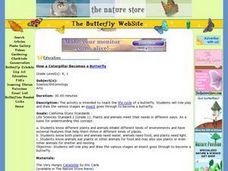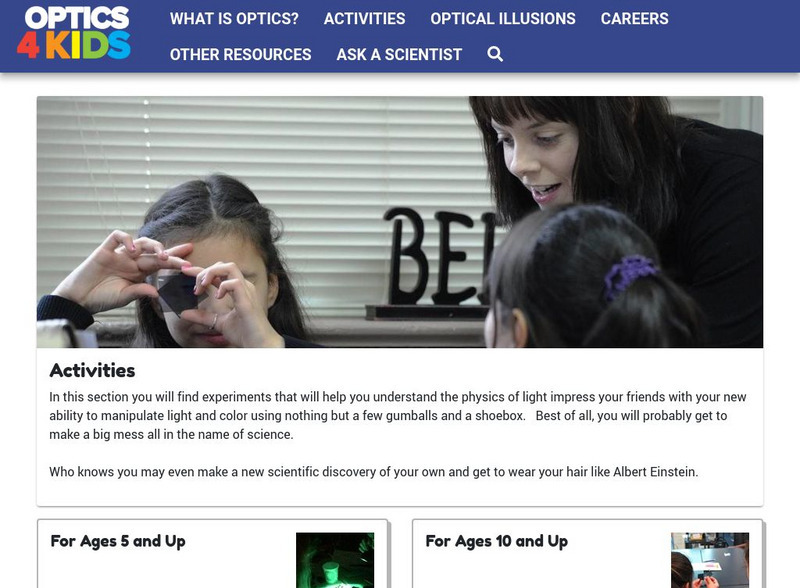Curated OER
What is the Function of Each Seed Part in the Growth of a Plant
Sixth graders investigate the parts of a seed by using a digital camera. In this botany lesson, 6th graders plant their own seeds in class and demonstrate the necessary attributes for growing a plant. Students utilize a camera to...
Curated OER
The View From Up Here: The Language and Art of Clouds
A lesson on the water cycle can develop into an exploration of art, and much more.
Curated OER
Spectral Surprise
Young scholars experience a model that produces, separating, and displaying spectral colors.
Curated OER
Create a Fan Design
Students design fans with organic shapes and contrasting colors. They recognize t'aeguk design as a visual element of Korean culture.
Curated OER
Realism: Landscape
Students watch videos and experiment with different mediums of art. Each day students create a project with different materials.
Curated OER
Remembrance Through Art
Learners examine the design for the Vietnam Veterans Memorial. They assess art's role in history. They demonstrate their knowledge by planning a memorial for a public space.
Curated OER
How a Caterpillar Becomes a Butterfly
Student role play and draw the various stages an insect goes through to become a butterfly. They discover the different stages of how a caterpillar becomes a butterfly. Students read The Very Hungry Caterpilla by Eric Carle.
National Gallery of Art
National Gallery of Art: The Elements of Art: Color
Students will be introduced to color, one of the basic elements of art, through analysis of works of art by Monet, Matisse, and Kandinsky. Class discussion focused on these paintings will help students understand how artists use color to...
Physics Classroom
The Physics Classroom: Light Waves and Color
The behavior of light waves is introduced and discussed. Also, polarization, color, diffraction, and interference are introduced and discussed thoroughly as supporting evidence of the wave nature of light.
Physics Classroom
The Physics Classroom: Light Waves and Color: Wavelike Behaviors of Light
In this series of interactive physics tutorials, students will focus on the wavelike nature of light.
Physics Classroom
The Physics Classroom: Light Waves and Color: Polarization
Through illustrated practice problems and video clips, students learn about polarization of light.
Physics Classroom
The Physics Classroom: Light Waves and Color: Thin Film Interference
Students investigate an example of interference that provides further evidence in support of the wavelike behavior of light.
Optical Society
Optical Society of America: Exploring the Science of Light: Easy Activities
A collection of simple experiments for exploring the basic properties of light and color.
South Carolina Educational Television
Know It All Media: Light and Color
Why do we see certain colors? This interactive animation demonstrates the concept of the visible spectrum, and how we see the different colors of the rainbow.
Florida State University
Florida State University: Light and Color: Reflection of Light
An in-depth discussion on reflection of light can be found here. Among the topics discussed include are the difference between specular and diffuse reflection, concave and convex mirrors, facets, total internal reflection, and much more....
Physics Classroom
The Physics Classroom: Light Waves/color: Absorption, Reflection, Transmission
In this physics classroom, students learn how and why light of certain frequencies can be selectively absorbed, reflected or transmitted.
Physics Classroom
The Physics Classroom: Wavelike Behaviors of Light
How light waves demonstrate their wave nature by reflection, refraction, and diffraction.
Florida State University
Florida State University: Molecular Expressions Microscopy Primer: Light and Color Refraction of Light
Comprehensive and sophisticated overview of light refraction includes an historical overview of the subject and explanations of the mathematics that underpin refractive indexes, the relative index of refraction, Snell's law, and light...
Physics Classroom
The Physics Classroom: Light Absorption, Reflection and Transmission
This tutorial explains light absorption, reflection and transmission in a clear and concise manner. Provides a "Check Your Understanding" section as well as additional links on color and light.
TeachEngineering
Teach Engineering: Learning Light's Properties
Students learn the basic properties of light--the concepts of light absorption, transmission, reflection and refraction, as well as the behavior of light during interference. Lecture information briefly addresses the electromagnetic...
NumberNut
Number Nut: Light and Colors
Discover the relationship between light and colors in this brief lesson. Links to related color identification activities, Color Memory Challenge and Identifying Colors Quiz. Immediate feedback given to responses that includes...
BBC
Bbc: Bitesize: Gcse: Physics: Reflection and Refraction
All waves will reflect and refract in the right circumstances. The reflection and refraction of light explain how people see images, color and even optical illusions. This tutorial discusses each concept and presents an experiment to try...
TeachEngineering
Teach Engineering: The Energy of Light
In this introduction to light energy, students learn about reflection and refraction as they learn that light travels in wave form. Through hands-on activities, they see how prisms, magnifying glasses and polarized lenses work. They also...


















